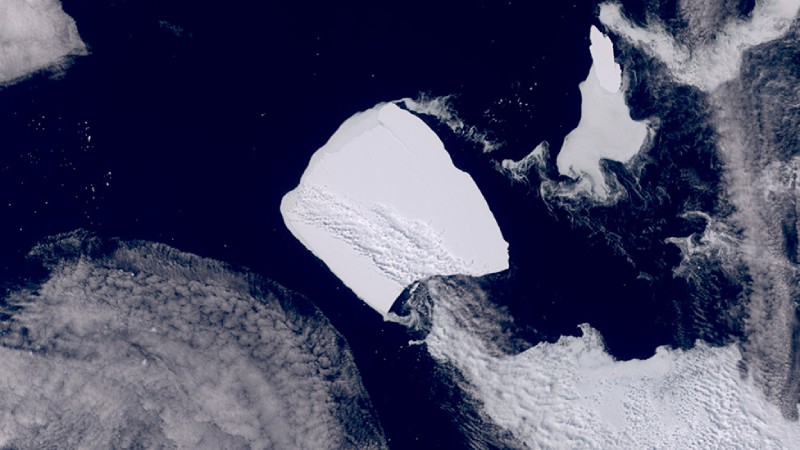Science
The largest iceberg in the world ‘A23a’ is moving after 30 years

The world’s biggest iceberg known as A23a, which formed in 1986 on the Filchner-Ronne Ice Shelf in West Antarctica, has recently undergone an extraordinary journey, ending its decades-long period of relative stillness.
A23a, the largest iceberg in the world, has left its permanent home of over thirty years to go on an uncommon journey. This enormous iceberg, which is about a trillion metric tonnes in weight and covers 4,000 square kilometers, formed in 1986 on the Filchner-Ronne Ice Shelf in West Antarctica.
The largest iceberg in the world, larger than twice the size of the capital of Britain, is moving after spending decades anchored to the Antarctic seafloor.
In 1986, the massive chunk of ice detached itself from the Filchner-Ronne ice shelf, calved, and nearly instantly settled on the Weddell Sea floor in the Antarctic.
The iceberg, known as A23a, is nearly 4,000 square kilometers (1,544 square miles) in area and approximately 400 meters (1,312 feet) thick. In contrast, Greater London encompasses 1,572 square kilometers or 607 square miles.
But now, almost 3 decades later, scientists Ella Gilbert and Oliver Marsh of the British Antarctic Survey said the iceberg has most likely gotten smaller enough to lose its hold on the seafloor as part of the ice shelf’s normal growth cycle and has begun to move.
Since the 1980s, A23a has held the title of “largest current iceberg” multiple times; however, they noted that icebergs that are larger but have a shorter lifespan, such as A68 in 2017 and A76 in 2021, have occasionally surpassed it.
The iceberg is currently moving five kilometers (three miles) per day and is expected to head eastward due to ocean currents.
Although this specific iceberg most likely broke off as a result of the ice shelf’s normal growth cycle, Gilbert and Marsh noted that Antarctica is losing a significant amount of ice annually due to climate change.
Current Affairs: The Biggest Iceberg in the World On The Move After 30 Years
Table of Contents
Breaking Free: A Rare Event
- A23a, which formerly housed a Soviet research station, has been a permanent fixture in the Weddell Sea, but new satellite photos show a significant shift in its status.
- A23a is moving for the first time in over thirty years. It is traveling past the Antarctic Peninsula’s northernmost point due to strong winds and ocean currents.
- Oliver Marsh, a glaciologist with the British Antarctic Survey, highlights the significance of closely monitoring the trajectory of this large iceberg and notes its unusual nature.
The Antarctic Circumpolar Current: A Potential Course
- With increasing velocity, A23a is expected to enter the Antarctic Circumpolar Current, a potent oceanic channel that may enable it to reach the Southern Ocean.
- Large icebergs are known to travel this path, also known as “iceberg alley,” through its murky waters.
- Concerns concerning possible effects on the environment are raised by the movement of such a large iceberg in this area.
A23a’s sudden movement
- According to Oliver Marsh, it’s possible that the iceberg thinned over time and gained the extra buoyancy required to lift off the ocean floor and be carried by currents.
- The intricacy of ice dynamics in the polar regions is highlighted by the ongoing investigation into the precise triggers for this event.
Potential Impacts: A Threat to South Georgia Island
- A23a may ground itself again, possibly at South Georgia Island.
- The island’s abundant wildlife, which includes millions of seals, penguins, and seabirds that breed and feed in the nearby waters, is threatened by this scenario.
- The marine ecosystem may suffer if the iceberg makes it difficult to access these important locations.
Echoes of the Past: Lessons from A68
- The circumstances surrounding A68, another huge iceberg, in 2020 are reminiscent of the situation with A23a.
- There were worries that A68 would crash into South Georgia, threatening marine life and obstructing the flow of food.
- Thankfully, A68 fragmented into smaller parts, preventing a possible disaster. This result emphasizes how big icebergs are dynamic and unpredictable, posing threats to human activity and the environment alike.
The Long Journey Ahead
- Though its final destination remains unknown, A23a’s massive bulk raises the possibility of a protracted voyage in the Southern Ocean.
- A23a may continue to persist and migrate further north, perhaps all the way to South Africa, even in warmer waters.
- This puts shipping lanes at risk and highlights the need for ongoing observation and study to comprehend these enormous icebergs’ behavior in a changing climate.
-

 Sports4 weeks ago
Sports4 weeks agoFIFA Club World Cup 2025: Complete List of Qualified Teams and Groups
-

 Sports3 weeks ago
Sports3 weeks agoAl Ahly vs Inter Miami, 2025 FIFA Club World Cup – Preview, Prediction, Predicted Lineups and How to Watch
-
Health2 weeks ago
Back to Roots: Ayurveda Offers Natural Cure for Common Hair Woes
-

 Tech2 weeks ago
Tech2 weeks agoFrom Soil to Silicon: The Rise of Agriculture AI and Drone Innovations in 2025
-

 Sports4 weeks ago
Sports4 weeks agoFIVB Men’s Volleyball Nations League 2025: Full Schedule, Fixtures, Format, Teams, Pools and How to Watch
-

 Startup3 weeks ago
Startup3 weeks agoHow Instagram Is Driving Global Social Media Marketing Trends
-

 Sports3 weeks ago
Sports3 weeks agoWorld Judo Championships 2025: Full Schedule, Date, Time, Key Athletes and How to Watch
-

 Sports2 weeks ago
Sports2 weeks agoFIBA 3×3 World Cup 2025: Full Schedule, Preview, and How to Watch













